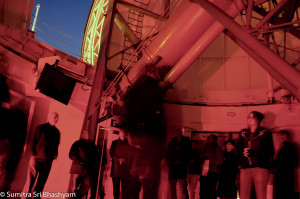November 22, 2016
Viewing with the Great Equatorial Telescope – 22 November 2016
Report by: Tej Dyal
 As you may know, we are at the mercy of the clouds when we desire a peep into the universe from the Great Equatorial Telescope. Sometimes, the weather just doesn’t play ball and, when that happens, ROG’s astronomers will still delight us with a variety of backup astronomy related programs to compensate.
As you may know, we are at the mercy of the clouds when we desire a peep into the universe from the Great Equatorial Telescope. Sometimes, the weather just doesn’t play ball and, when that happens, ROG’s astronomers will still delight us with a variety of backup astronomy related programs to compensate.
However, on this evening, no such backup program was needed! The skies partly opened up for us and our ROG Astronomer, Brendan Owens, seized the opportunity to give us the most memorable and privileged experience of looking through the historical 28-inch Refractor. He was on fire as he masterfully navigated the scope onto several targets in between the clouds.
Our first stop was at one of the oldest globular clusters in our galaxy, M15. A fitting target for this equally ancient large telescope. We learnt that this was a distant cluster of 300,000 stars, lying outside and below the plane of our galaxy. Many of the stars are nearly as old as the universe at 12-13 billion years (our universe is 13.8 billion years old). But at just 175 light years in diameter, this is a incredibly densely packed cluster. Its core is so packed that it hides many mysteries, one of which could be a black hole. The eyepiece showed a fuzzy object and indeed had a bright central core that then fades outwards. The longer we lingered on it, the more this globular cluster stretched out. Amazing.
Next cosmic stop was Albireo, a very contrasting double star. We observed how two stars are distinctly different in their colours, one being very orange whilst the other star had a distinct bluish hue. Brendan narrates that this is arguably a true binary system in that the two stars orbit each other as opposed to double stars that optically appear close together from our viewing perception but are in fact unconnected and are at vast distances from each other. It is still debated on if this is a binary because the two stars are actually very far apart, so far apart that it takes 100,000 years to complete one orbit around each other. The verdict is still out on that until more data is accumulated but regardless, we just loved the colours pouring from them in the eyepiece.
Brendan then navigated the scope towards M57, The Ring Nebula. This was a lovely object to observe for members as some remarked how they were surprised to find how justified the naming of this object was, for we could indeed see quite literally, a perfect ring in space. Mind you, it was a challenge to snap this object into view and for some of us, we needed to adopt the method of averted vision (looking slightly away from the object) for it to pop into view. But when it did, it was startlingly huge in the eyepiece. One moment you see nothing, next a huge bloody ring appears! I would personally rename this as Gollum’s Ring Nebula. Brendan explained that this is categorised as a planetary nebula, typically formed by a dying giant star violently shedding its materials outwards, hence the nebula’s ring shape. The giant star then became a white dwarf which, through the 28-inch, can be potentially observed in the centre of the ring. Sadly, the seeing conditions weren’t good enough on the night to see that white dwarf. Nevertheless, the size and brightness of the ring itself was quite an amazing sight of itself.
At this point we were hugely satisfied with Brendan’s energetic tour and as we noticed him looking hurriedly at the time, I was about to thank him for a wonderful tour when he suddenly interjected with an excited “looks like we should have enough time for one more target” and with youthful speed, Brendan slewed the telescope onto our bonus final target, Uranus.
Brenden described many interesting attributes of this gas giant, one being that its polar axis is tilted so much that it rotates sideways compared to all the other planets. Considering this gas planet, second furthest from the Sun, is roughly 3 billion km away from us, it was amazing to observe this planet’s lovey green tint and distinctly spherical appearance in the eyepiece.
And so that marked the ending of a remarkable whirlwind tour through the vintage refractor. Flamsteed members were very delighted, expressing gratitude to Brendan for his generosity of giving his time to entertain us with such enthusiasm and vigour.
If you would like to discuss/chat or ask questions about our events or anything about astronomy, or share your own astronomy related experience, please do come and ask/chat away on our members forum at http://www.flamsteed.org.uk/forums/
Posted under: 28-Inch Equatorial Viewing, Flamsteed, Meeting Report, Observing and Imaging Group

You must be logged in to post a comment.